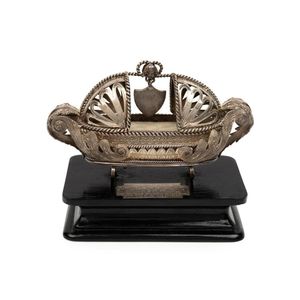Antique Australian Silver Christening Cradle by W. Kerr (1898)
An Australian silver christening cradle by W. Kerr of Sydney, circa 1898, the ornately decorated double ended cradle with pierced and applied acanthus scrolls and repeating classical motif banding raised on an ebonised rectangular wooden base set with a presentation plaque inscribed 'Presented to Alderman J. B. Anderson, Mayor of Mosman by the Alderman and Ex Alderman with their hearty felicitations on the occasion of the birth of his twin children, 17th March 1898', conforming glass dome, 2.5 cm high, 15 cm wide. Provenance: The Trevor Kennedy collection. Other Notes: William Kerr came to Australia from Northern Ireland in 1839 and opened premises on Wharf Road, Balmain in 1875. He moved to larger premises at 574 George Street in 1876 with the business continuing there until 1938. Kerr received a commendation for his work at the Sydney international exhibition in 1879., James Ball Anderson, builder and architect, resident of 79 Raglan Street, Mosman, was elected as an Alderman of Mosman Council in 1894 and served as Mayor 1898-99. He retired as an Alderman in 1903. He had seven children and the twins referred to in the above inscription were Doreen and Dudley.
You must be a subscriber, and be logged in to view price and dealer details.
Subscribe Now to view actual auction price for this item
When you subscribe, you have the option of setting the currency in which to display prices to $Au, $US, $NZ or Stg.
This item has been sold, and the description, image and price are for reference purposes only.
- Acanthus - A stylized leaf motif, one of the primary decorative elements of classical Greek and Roman architecture, derived from the genus of flowering plants in the family Acanthaceae, native to tropical and subtropical regions of the Mediterranean area. It is a common element in classical Greek and Roman design, and is often seen in Corinthian and Composite order columns and used as a decorative element in English, European and Australian furniture, particularly on the curve of a leg, and as decoration for a corbel.
- Circa - A Latin term meaning 'about', often used in the antique trade to give an approximate date for the piece, usually considered to be five years on either side of the circa year. Thus, circa 1900 means the piece was made about 1900, probably between 1895 and 1905. The expression is sometimes abbreviated to c.1900.
This item has been included into following indexes:
